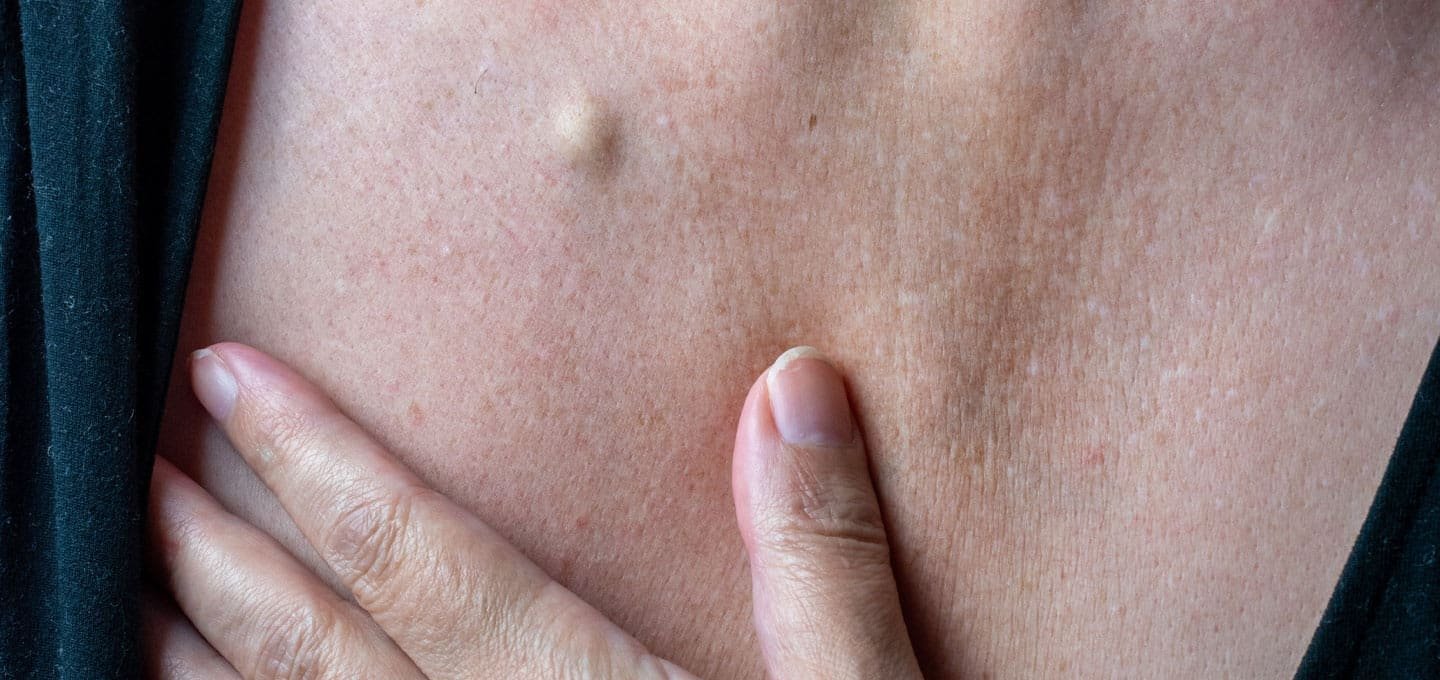What is a Sebaceous Cyst?
Sebaceous cyst is a benign, closed sac-like structure that forms beneath the skin, typically filled with a substance known as sebaceous material, which is rich in keratin. These cysts arise due to the obstruction of sebaceous glands, which are responsible for secreting sebum – a natural oil that lubricates the skin and hair. The blockage can occur for various reasons, such as injury to the skin, hormonal changes, or genetic factors. Unlike epidermoid cysts and other cyst types, sebaceous cysts originate specifically from sebaceous glands, making their composition and pathology unique.
Common symptoms of a sebaceous cyst include a palpable lump under the skin, which may vary in size, and can sometimes be tender or inflamed if infected. A sebaceous cyst may also exhibit a characteristic yellow or white appearance through the skin, often causing discomfort for the individual. These cysts are generally harmless; however, they can become problematic if they grow in size, become painful, or if the skin over them ruptures, leading to potential infection.
Surgical removal of sebaceous cysts is often recommended when they cause discomfort or a risk of infection. While these cysts can be treated effectively, their healing timeline post-surgery can vary based on factors like location, size, and individual healing response. Proper post-operative care is also vital in minimizing complications and ensuring a smoother recovery process. By comprehending the nuances of sebaceous cysts and their potential need for surgical intervention, individuals can better prepare for the healing journey ahead.
Typical Healing Time: An Overview
Understanding the healing timeline of sebaceous cyst wounds is crucial for patients undergoing surgical removal. Typically, the healing process for these wounds can range from 1 to 4 weeks, depending on various factors. The size and depth of the cyst play a significant role in determining recovery time. Larger and deeper cysts often require more extensive surgical methods, which can lead to a longer healing period due to the increased tissue trauma involved.
Another important factor is the surgical technique employed for the removal of the sebaceous cyst. Minimally invasive techniques may reduce healing time considerably compared to more traditional approaches that may involve larger incisions. For instance, an excised cyst usually requires a more lengthy recovery process due to both the extent of the incision and potential complications. The skill and experience of the surgeon also contribute to the overall efficacy of the procedure and subsequent healing time.
Complications such as infections or inflammation may significantly hinder the healing process. If a sebaceous cyst becomes infected, recovery can be prolonged, leading to additional medical treatments. Patients with underlying conditions affecting the immune system may also experience longer healing times. Monitoring the wound for signs of complications is essential to ensure prompt medical attention if necessary.
To provide clarity on these varying healing times, a chart comparing recovery durations based on the aforementioned factors can be quite beneficial. This visual representation will highlight not only the typical healing range but also the impact of specific variables. Ultimately, while many individuals may heal within the standard timeframe, being aware of these influencing factors is vital for setting realistic expectations for recovery.
Stages of Healing After Sebaceous Cyst Removal
After sebaceous cyst removal, the healing process can be divided into three key stages: initial inflammation, tissue repair, and maturation. Understanding these phases is crucial for patients as it provides insights into what to expect during recovery and helps identify any potential complications that may arise.
The first stage, initial inflammation, typically occurs immediately after the surgical procedure. During this phase, the body responds to tissue injury by initiating inflammation, which can lead to swelling, redness, and some degree of pain around the incision site. This inflammatory response is a natural part of the healing process, signaling the body to start repairing the damaged area. Patients may also notice the formation of a small amount of discharge as the body works to clear away any debris and prevent infection. It’s essential to monitor these symptoms closely; while some inflammation is normal, excessive swelling, severe pain, or a change in the color of the discharge can signal complications that require medical attention.
The second stage, tissue repair, generally begins within a few days post-surgery and can last for several weeks. During this period, new tissue forms as the body rebuilds the damaged skin and underlying layers. Patients may experience some stiffness and tenderness as the remodeling occurs. As part of the healing process, the wound should gradually begin to close, and the risk of infection diminishes. Proper wound care instructions provided by the healthcare provider are critical, and patients should adhere strictly to these guidelines to promote optimal healing.
Finally, the maturation stage can extend for months, and sometimes up to a year, depending on various factors including individual healing capacity. In this phase, the newly formed tissue strengthens and integrates with the surrounding skin. Patients can help this process by maintaining a healthy lifestyle, including proper nutrition and hydration. Close observation for signs of complications, such as persistent redness or unusual growth around the site, is vital throughout the recovery timeline.
Factors Influencing the Healing Process
The healing timeline of sebaceous cyst wounds can be significantly influenced by various factors, both intrinsic and extrinsic. One of the primary personal health factors is the individual’s age. Younger individuals typically experience faster healing due to better vascularization and tissue regeneration capabilities. Conversely, older adults may face prolonged healing times due to decreased cellular turnover and the presence of underlying health conditions.
Underlying health conditions such as diabetes or autoimmune diseases can also impact the healing process. Conditions that compromise the immune system may increase the risk of infection, thus extending recovery time. Likewise, individuals on certain medications, including corticosteroids, may have altered healing responses, further complicating the timeline of recovery from a sebaceous cyst wound.
The surgical technique utilized for cyst removal is another critical component. Excision of the cyst, which involves removing the entire cyst wall, generally promotes clearer margins and minimizes recurrence, but may lead to a longer healing time compared to drainage, which is a less invasive approach. However, drainage may not eliminate the cyst’s sac entirely, and thus, can result in potential reinfection or recurrence.
Post-operative care is equally vital in influencing the healing timeline of sebaceous cyst wounds. Proper wound care, including keeping the area clean and protected, can significantly decrease the likelihood of infection. It is also crucial to follow the physician’s advice regarding activities to avoid during recovery, as engagement in strenuous activities may hinder the healing process.
Inflammation and the presence of infection play pivotal roles in wound healing. Effective management of inflammation and quick intervention in response to signs of infection can help facilitate a faster healing process. To promote optimal recovery, individuals are advised to maintain a balanced diet rich in vitamins and minerals, stay hydrated, and consider gentle mobility to stimulate circulation, which aids healing.






